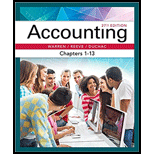
1.
It is that form of organization which is owned and managed by two or more persons who invest and share the
To prepare: An income statement for 20Y3, indicating the division of the income.
1.
Explanation of Solution
The income statement for 20Y3 of L&Y is as follows:
| L &Y | ||
| Income Statement | ||
| For the Year Ended December 31, 20Y3 | ||
| Professional fees | $395,300 | |
| Operating expenses: | ||
| Salary expense | $154,500 | |
|
| $15,700 | |
| Property tax expense | $12,000 | |
| Heating and lighting expense | $8,500 | |
| Supplies expense | $6,000 | |
| Depreciation expense—office equipment | $5,000 | |
| Miscellaneous expense | $3,600 | |
| Total operating expenses | $205,300 | |
| Net income | $190,000 | |
Table (1)
Hence, the net income of L&Y for the year 20Y3 is $190,000.
Division of net income:
The following table shows the division of net income between the partners.
| L | Y | Total | |
| Salary allowance………………… | $45,000 | $54,700 | $99,700 |
| Interest allowance…………… | $13,500 (1) |
$7,800 (2) | $21,300 |
| Remaining income (1:1)………… | $34,500 | $34,500 | $69,000 |
| Net income…………… | $93,000 | $97,000 | $190,000 |
Table (2)
Working note for the calculation of Interest allowance of L & Y
Interest Allowance is at 10%:
(1)
(2)
Note: Y invested additional $10000 on April 10, 20Y3, So, it should not be considered for calculating Interest allowance. So Y’s Capital at the beginning of the year is $78,000
Hence, L & Y partners will get $93,000 and $97,000 respectively from the net income.
2.
To prepare: The statement of partnership equity for 20Y3.
2.
Explanation of Solution
Statement of partnership equity:
The statement of partnership equity contains the changes in the partners’ capital account over a period of time. The changes in capital accounts of partners may occur due to the addition of the capital, net income or withdrawals.
The statement of partnership equity for 20Y3 is as follows:
| L &Y | |||
| Statement of Partnership Equity | |||
| For the Year Ended December 31, 20Y3 | |||
| L | Y | Total | |
| Balances, January 1, 20Y3 | $135,000 | $78,000 | $213,000 |
| Capital additions | 10000 | 10000 | |
| Net income for the year | 93000 | 97000 | 190000 |
| Partner withdrawals | ($50,000) | ($60,000) | ($110,000) |
| Balances, December 31, 20Y3 | $178,000 | $125,000 | $303,000 |
Table (3)
Hence, the capital accounts of L & Y partners show $178,000 and $125,000 respectively at the end of the period.
3.
To prepare: The
3.
Explanation of Solution
The balance sheet of L&Y at the end of 20Y3 is as follows:
| L&Y | |||
| Balance Sheet | |||
| December 31, 20Y3 | |||
| Assets | |||
| Current assets: | |||
| Cash | $34,000 | ||
|
| $47,800 | ||
| Supplies | $2,000 | ||
| Total current assets | $83,800 | ||
| Property, plant, and equipment: | |||
| Land | $120,000 | ||
| Building | $157,500 | ||
|
Less | $67,200 | $90,300 | |
| Office equipment | $63,600 | ||
| Less accumulated depreciation | $21,700 | $41,900 | |
| Total property, plant, and equip. | $252,200 | ||
| Total assets | $336,000 | ||
| Liabilities | |||
| Current liabilities: | |||
| Accounts payable | $27,900 | ||
| Salaries payable | $5,100 | ||
| Total liabilities | $33,000 | ||
| Partners’ Equity | |||
| L, capital | $178,000 | ||
| Y, capital | $125,000 | ||
| Total partners’ equity | $303,000 | ||
| Total liabilities and partners’ equity | $336,000 | ||
Hence, the assets total matches with total liabilities and partners’ equity in the balance sheet, on the date of formation of partnership.
Want to see more full solutions like this?
Chapter 12 Solutions
Bundle: Accounting, Chapters 1-13, 27th + Cengagenowv2, 2 Terms Printed Access Card For Warren/reeve/duchac's Accounting, 27th
 College Accounting, Chapters 1-27AccountingISBN:9781337794756Author:HEINTZ, James A.Publisher:Cengage Learning,Century 21 Accounting Multicolumn JournalAccountingISBN:9781337679503Author:GilbertsonPublisher:Cengage
College Accounting, Chapters 1-27AccountingISBN:9781337794756Author:HEINTZ, James A.Publisher:Cengage Learning,Century 21 Accounting Multicolumn JournalAccountingISBN:9781337679503Author:GilbertsonPublisher:Cengage Financial AccountingAccountingISBN:9781305088436Author:Carl Warren, Jim Reeve, Jonathan DuchacPublisher:Cengage Learning
Financial AccountingAccountingISBN:9781305088436Author:Carl Warren, Jim Reeve, Jonathan DuchacPublisher:Cengage Learning Financial AccountingAccountingISBN:9781337272124Author:Carl Warren, James M. Reeve, Jonathan DuchacPublisher:Cengage Learning
Financial AccountingAccountingISBN:9781337272124Author:Carl Warren, James M. Reeve, Jonathan DuchacPublisher:Cengage Learning





